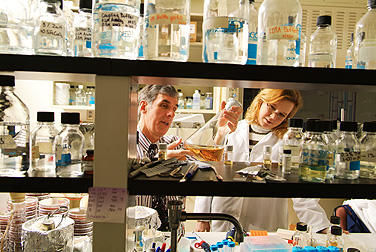News
Stimulus funding continues to flow to UB

UB researchers have been awarded nearly $31 million in funding through the American Recovery and Reinvestment Act. Photo: DOUGLAS LEVERE
-
 Print
Print -
 Comments
Comments
-
“The sizable investment in UB research, and the resulting job and knowledge creation, demonstrate the success and great potential of the Recovery Act.”
Although President Obama’s visit to the region last week was intended to highlight the successes of a small manufacturing plant in Buffalo, his arrival also presents an opportunity to underscore the success of his administration’s major investment in scientific research at UB.
Since the February 2009 introduction of the Obama administration’s American Recovery and Reinvestment Act, UB has received 86 federal research awards totaling nearly $31 million. This funding is supporting many innovative UB research projects, ranging from investigating the underlying causes of heart disease to developing nanotechnology therapies for treatment of drug-resistant flu viruses.
Among the total investment, UB faculty members also have received $8.5 million in new instrumentation grants to purchase or develop instruments that enhance their work. These specialized awards allow UB researchers to upgrade the university’s existing research enterprise and open new doors for scientific exploration.
Most of the funding is distributed by the National Institutes of Health (NIH), the National Science Foundation (NSF) and other federal scientific agencies supported by the Recovery Act. Click here for a summary of UB research funded by the Recovery Act.
As a result of the wide-ranging Recovery Act investment, UB has created or retained 84 jobs at the university through March 31, and university officials anticipate creating dozens more. The work of these researchers and technicians is laying the foundation for UB’s long-term impact on Western New York’s economy. In the short term, the funded research at UB is generating new jobs and supporting local businesses through contracts with local vendors and the purchase of supporting research equipment and supplies locally and elsewhere.
The NIH estimates that each dollar invested in basic research stimulates $2.50 in associated economic activity. In all, the Recovery Act has injected $21.5 billion in new investment for research at U.S. universities, research museums and non-profit research institutions.
“The sizable investment in UB research, and the resulting job and knowledge creation, demonstrate the success and great potential of the Recovery Act,” says Jorge V. José, vice president for research. “Much of this research will lay the foundation for Western New York’s economic future and will improve quality of life in our region. It has the potential to spin off new industries, businesses and jobs in our region.”
The $1 million awarded in April to Laurene Tumiel-Berhalter, associate professor and vice chair for research in the Department of Family Medicine, by the National Center for Minority Health and Health Disparities is an excellent example of Recovery Act funding at work, José points out.
Tumiel-Berhlater’s project to improve cancer screening in minorities—working with community partners—is funding eight jobs locally. Moreover, the study will lay the groundwork for a larger, multi-year project that will improve cancer prevention in low-income communities, where seeing a doctor or various specialists can be difficult.
Ezra Zubrow, professor of anthropology, is part of an international research team investigating arctic climate change funded by more than $1 million from the NSF's Arctic Social Sciences Program, which is supported by the Recovery Act.
Most of the Recovery Act money used in the project is spent in the United States on salaries and research at various universities, Zubrow notes. “This research funding is good for science, good for the economy, good for the government and good for the international reputation of the United States,” he says.
Other examples of Recovery Act-funded research at UB include the investigation of inflammatory biomarkers in human saliva as a way to predict the occurrence of chronic disease. Thus far, five jobs have been created or retained at UB to date as a result of this research, which is funded by $950,000 from the NIH’s National Institute of Dental and Craniofacial Research. Jean Wactawski-Wende, professor of social and preventive medicine, is the project’s principal investigator.
And UB research on the use of “gold nanorods” may lead to FDA Phase 1 clinical trials to investigate how this nanomaterial can be used to combat avian flu and other drug-resistant flu viruses. This research, funded by $780,000 from the National Institute of Allergy and Infectious Diseases, is responsible for four UB jobs. Paul Knight, professor of anesthesiology and microbiology, is principal investigator.
Among UB’s Recovery Act instrumentation grants, Vipin Chaudhary, associate professor of computer science and engineering, received $4.6 million to acquire a supercomputer that will enhance UB’s computing infrastructure and provide improved data-mining and processing power, memory and storage capabilities for approximately 250 immediate users. Classes, tutorials and workshops will bring high-performance computing to UB students and faculty, as well as to researchers in Western New York and nationally.
Instrumentation grants are distributed by the NSF’s Major Research Instrumentation Program-Recovery and Reinvestment, and the NIH’s National Center for Research Resources.

Reader Comments